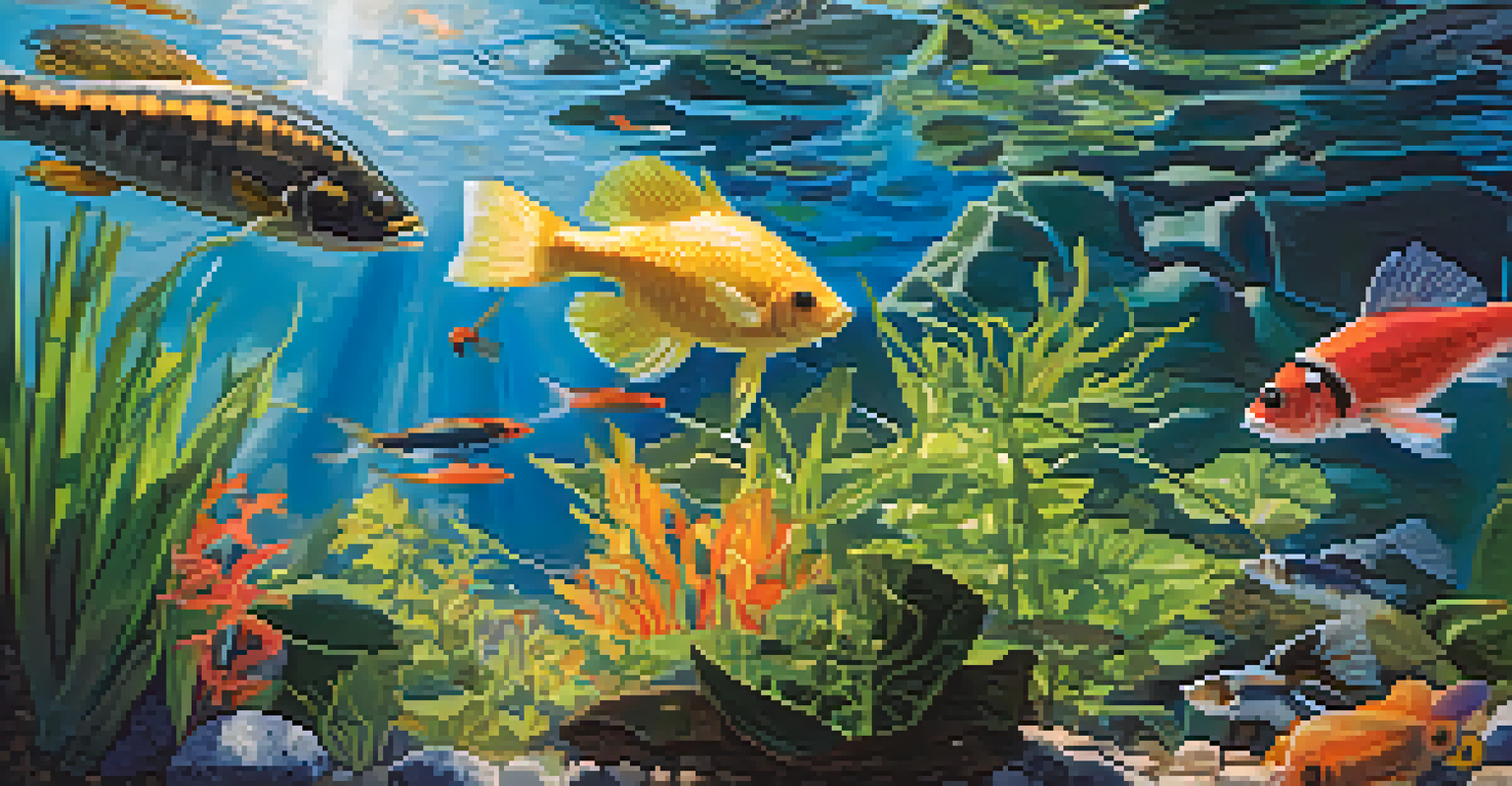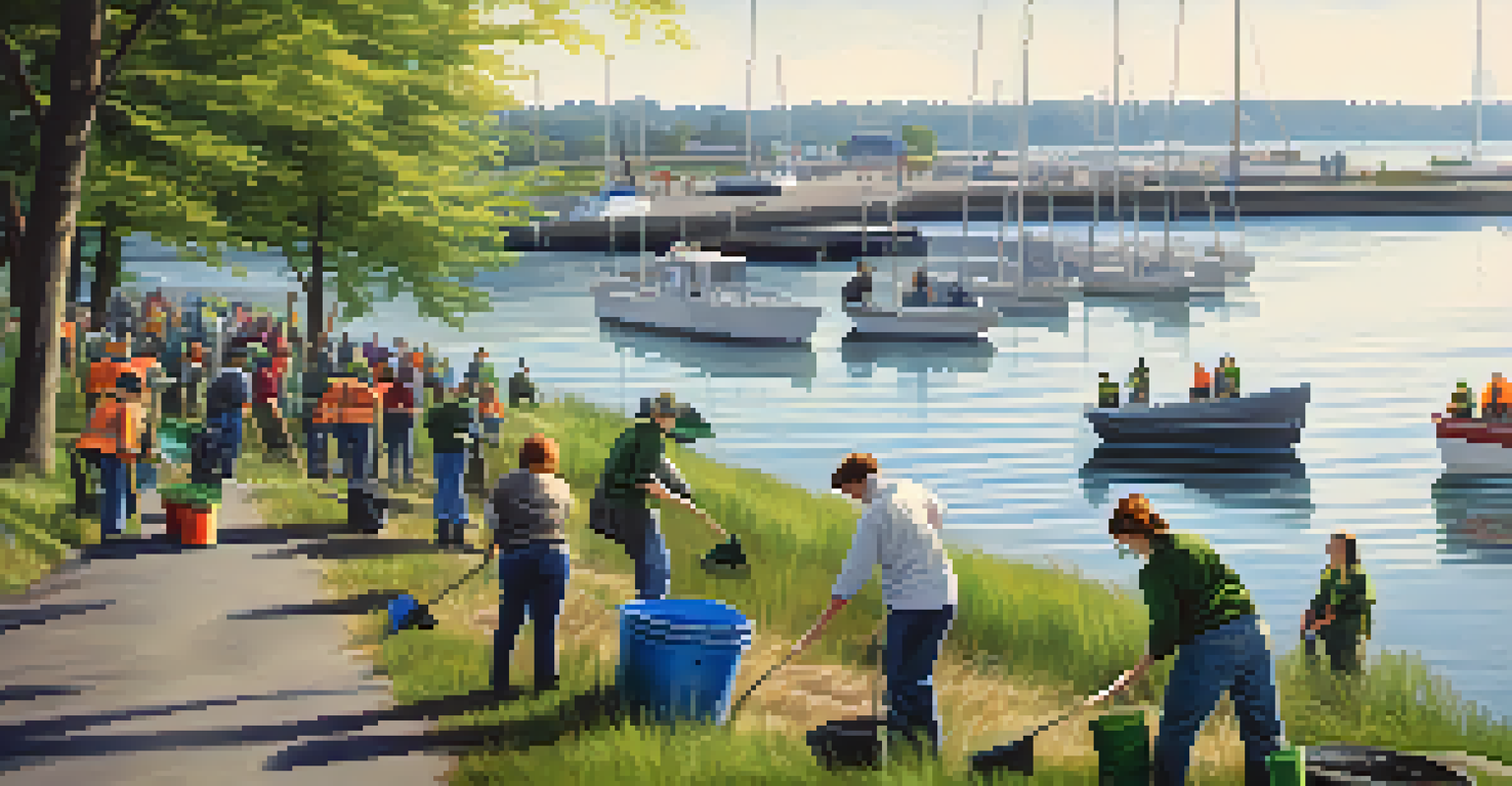Impact of Climate Change on Buffalo's Great Lakes Ecosystem

Understanding the Great Lakes Ecosystem in Buffalo
The Great Lakes ecosystem is a vital resource for Buffalo, providing drinking water, recreation, and habitat for wildlife. This interconnected system is home to diverse species, including fish, birds, and plants, all of which rely on its health for survival. Understanding this ecosystem is crucial as it helps us appreciate the balance of nature and the importance of conservation.
In every walk with nature one receives far more than he seeks.
In Buffalo, the Great Lakes serve not just as a body of water but as a lifeline for the community. They support the local economy through tourism and fishing, creating jobs and fostering a connection between residents and nature. However, this delicate balance is increasingly threatened by the impacts of climate change.
The ecosystem's health is a reflection of the environment's overall condition. As climate change disrupts weather patterns, it alters the conditions necessary for various species to thrive, leading to potential long-term consequences for both the wildlife and the local economy.
Rising Temperatures and Their Effects
One significant impact of climate change in the Great Lakes region is the rise in water temperatures. Warmer water can lead to decreased oxygen levels, which are crucial for fish and other aquatic organisms. This change can disrupt local fisheries and the livelihoods that depend on them.

Additionally, higher temperatures can promote the growth of harmful algal blooms. These blooms not only affect water quality but can also produce toxins harmful to both wildlife and humans. This poses a serious public health risk and threatens the recreational activities that many Buffalo residents enjoy.
Climate Change Threatens Ecosystem
Rising temperatures and altered weather patterns are disrupting the delicate balance of the Great Lakes ecosystem, impacting wildlife and local economies.
As temperatures continue to rise, the ecological balance within the lakes is at stake. Species that are less tolerant to warm water may decline, leading to a shift in the ecosystem's structure and potentially reducing biodiversity.
Increased Precipitation and Its Consequences
Climate change has also led to increased precipitation in the Buffalo area. While rain is essential for replenishing water supplies, excessive rainfall can lead to runoff that carries pollutants into the lakes. This runoff can harm aquatic life and degrade water quality, making it unsafe for both wildlife and recreational use.
The environment is where we all meet; where we all have a mutual interest; it is the one thing all of us share.
Moreover, heavy rains can exacerbate flooding, which poses risks to infrastructure and habitats. Flooded areas may destroy crucial habitats for species such as turtles and shorebirds, further jeopardizing their populations. These changes can have cascading effects throughout the entire ecosystem.
Ultimately, increased precipitation challenges the resilience of the Great Lakes. The ecosystem must adapt to these changes, but the pressure from pollution and habitat loss complicates this adaptation process.
Shifts in Species Distribution
As the climate continues to change, many species in the Great Lakes region are experiencing shifts in their distribution. Warmer water temperatures and altered habitats can push some fish species northward, leaving local fishermen and ecosystems in a bind. This shift can lead to a decline in traditional fishing practices that have been part of Buffalo's culture for generations.
Invasive species, often more adaptable to changing conditions, may thrive in this new environment. This can lead to increased competition for resources, which further threatens native species. The introduction of new species can also disrupt the food web, leading to unforeseen consequences for the entire ecosystem.
Community Takes Action for Conservation
Buffalo residents and organizations are actively developing strategies to combat climate change effects through pollution reduction and habitat restoration initiatives.
Understanding these shifts is essential for conservation efforts. By recognizing which species are at risk and how they interact with their environment, we can better strategize to protect both the ecosystem and the community's relationship with it.
Impact on Local Wildlife and Biodiversity
Climate change poses a serious threat to local wildlife and biodiversity in Buffalo's Great Lakes ecosystem. As habitats change due to rising temperatures and fluctuating water levels, many native species struggle to adapt. This can lead to decreased populations and, in some cases, extinction.
Bird species that rely on specific conditions for nesting and feeding may find their habitats altered or destroyed. For example, shorebirds depend on specific water levels for nesting, and changes in these levels can drastically reduce their breeding success. Similarly, fish species may find their spawning grounds compromised, impacting their lifecycle.
Conserving biodiversity is crucial not just for the species themselves but for the entire ecosystem's health. A diverse ecosystem is more resilient and better equipped to handle environmental changes, making it vital to implement measures that protect these species and their habitats.
Community Response and Adaptation Strategies
The Buffalo community is not standing idly by in the face of climate change. Local organizations, government agencies, and citizens are coming together to develop strategies aimed at protecting the Great Lakes ecosystem. This includes initiatives focused on pollution reduction, habitat restoration, and sustainable fishing practices.
Education plays a significant role in these community efforts. By raising awareness about the impacts of climate change, residents are encouraged to participate in conservation activities, such as clean-up events and tree planting. These actions help foster a sense of ownership and responsibility towards the local environment.
Species Shifts Impact Local Biodiversity
Changes in species distribution due to climate change threaten native wildlife and challenge traditional fishing practices that are integral to Buffalo's culture.
Adaptation strategies can also include the development of green infrastructure, like rain gardens and permeable pavements, which help manage stormwater runoff. By implementing these solutions, Buffalo can enhance its resilience to climate change while preserving the beauty and health of the Great Lakes.
The Future of Buffalo's Great Lakes Ecosystem
Looking ahead, the future of Buffalo's Great Lakes ecosystem hinges on our collective action and commitment to sustainability. While climate change presents significant challenges, it also offers an opportunity for communities to innovate and adapt. By investing in green technologies and practices, Buffalo can lead the way in environmental stewardship.
Continued collaboration among stakeholders—government, businesses, and residents—is essential for crafting effective policies that address climate change impacts. This cooperative approach can ensure that the needs of the ecosystem and the community are balanced, paving the way for a healthier environment.

Ultimately, the fate of the Great Lakes ecosystem is intertwined with our daily choices and behaviors. By prioritizing sustainability, we can help secure a vibrant future for both Buffalo's natural environment and its residents.